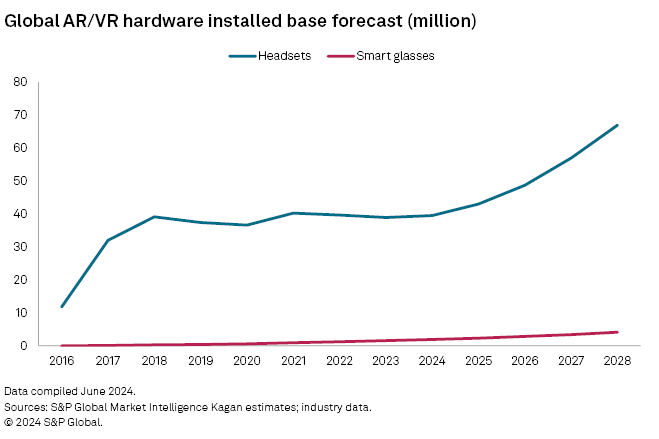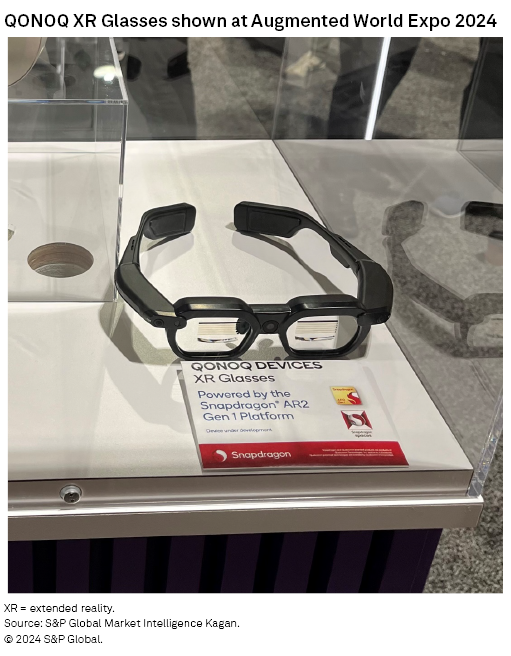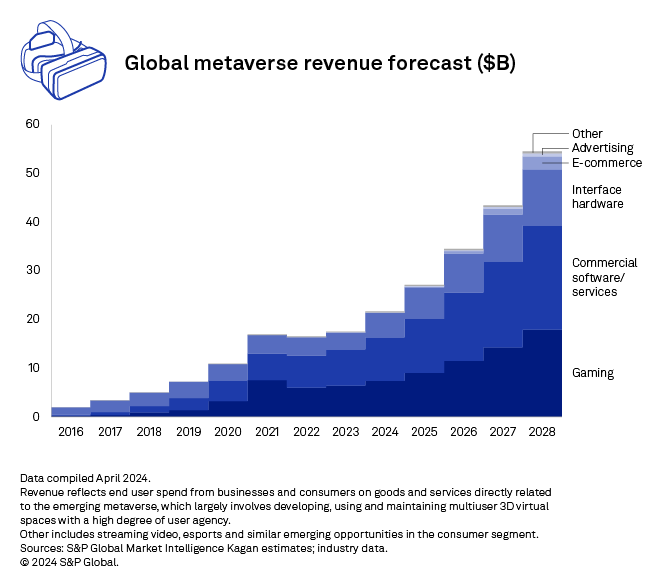The Augmented World Expo moved to Long Beach, Calif., in 2024 after outgrowing the Santa Clara Convention Center, its home base since 2010, as the growing footprint of digital experiences in our everyday lives puts more eyes on the potential of augmented and virtual reality.

Perhaps unsurprisingly, generative AI was top of mind at this year's expo (AWE), with virtual world developers and hardware vendors eager to accelerate their path to delivering crucial functionality and killer apps.
Augmented reality devices have long promised to reduce friction around delivering information about the world around us: Who is this person in front of me? What are the key points of reference near me? What are some ways to alter this space?
What sets head-mounted AR/VR devices apart from phones and laptops as AI platforms is that they "see what I see." Front-facing sensors and cameras can feed an AI the context it needs to directly address queries related to the user's current situation.
Instead of having to lift a phone to take a picture or type out a long text description, a user could simply say "what am I looking at?" and be rewarded with useful data.

Meta Platforms Inc. is already doing this to some degree with its audio-only Ray-Ban smart glasses, which deliver a generative AI output to the user via a synthesized voice.
The next stage would be delivering that data to the user visually. Think of seeing data in an instrument panel or mapped on a timeline, all without having to lose sight of the world around you.
While we believe that smart glasses are the goal for most AR/VR hardware vendors, we do not believe that such devices will reach the mass market over the next five years. Instead, headsets are likely to remain the predominant form factor, due largely to more cost-effective performance, display and input options.

That is to say, we do not expect the kinds of smart glasses outlined in this report to ramp significantly over the next five years. The core concepts are well articulated, but the tech is not there to deliver on practical mass-market devices.
To underline the eventual convergence of advanced wearables and AI, QUALCOMM Inc. said at the show that Ziad Asghar would be moving into a senior vice president role at the company's XR division, bringing with him an AI focus from his former position as senior vice president of product management.
Asghar and Qualcomm XR business lead Said Bakadir sat down with a small group of analysts at the show to outline how the group could bridge the divide between generative AI and augmented reality.
To illustrate that story, the company led with the first product to sport its Snapdragon AR2 Gen 1 chipset in NTT QONOQ Inc.'s XR Glasses.
The QONOQ demo on the show floor allowed users to push and pull at 3D models superimposed on clear eyeglass frames. This was one of the strongest AR smart glasses demonstrations we have seen so far in terms of hand tracking accuracy and image quality, even if the field of view was constrained.
The QONOQ’s key AI implementation is real-time interpretation and translation of conversations going on within earshot of the headset, but its front-facing camera could open the door for more elaborate GenAI applications in the future.
The primary drawback is that the QONOQ XR glasses require wireless connectivity to a smartphone, asking users to sacrifice battery life for the sake of AR. The other drawback is that they are still a little bulky to be confused for regular glasses.

The device is being positioned by Japanese telecom NTT Docomo Inc. to drive sales of high-end phones and is expected to be available for consumers and commercial customers later this year.
Shenzhen Yicang Technology Co. Ltd., doing business as XREAL, believes that it has found a sensible way to bridge the gap between the tethered smart glasses of the present and its vision of stand-alone units in the future: bundling smart glasses with a smartphone-sized Android tablet.
Read: XREAL took a $60 million mature round in January after a strong showing of its Air 2 Ultra AR smart glasses at CES.
Its Beam Pro device retails for $200 and starts shipping later this year. For the money, XREAL users get a Vision Pro-like interface delivered to smart glasses and the ability to see two apps at once.
The Beam Pro is GSM certified, meaning it is compatible with the Google Play App Library. It has dual front-facing lenses that can be used to take 3D pictures in a format that can be viewed with XREAL smart glasses as well as other AR/VR devices such as the Quest 3 and Vision Pro.
XREAL's smart glasses are still more of a personal display viewer than a robust AR platform, but its new Air 2 Ultra units combined with the Beam Pro start to approach core AR features, such as anchoring imagery in space. And, once again, front-facing cameras offer the opportunity to incorporate the AI based "see what I see" applications discussed above.
Qualcomm is also supplying the core chipset for the Beam Pro with the new Spatial Companion Processing chipset.
Qualcomm has quietly become the center of the AR/VR universe in recent years, regularly iterating its core products and working closely with key vendors to unlock new use cases.
Asghar made a point to underline that applications built on the Snapdragon Spaces development platform would be forward compatible with the forthcoming AR/VR-focused platform from Alphabet Inc.
The assurance came with an implied sigh of relief from Qualcomm, that after nearly a decade of trying to address both the hardware and software needs of a quickly evolving industry, Alphabet may soon be on the way to carry some of the load, at least in terms of developer support.
The waveguide wars continue
XREAL is the last big holdout of birdbath display technology, which requires a relatively bulky display tech near the eyes, but most companies building smart glasses, including NTT, have zeroed in on waveguide displays, which can be packed into the lenses and arms of smart glasses.
The challenge is cost. Producing a robust image with waveguide is an expensive proposition. Many of the waveguide smart glasses that have come to market have a relatively small field of view, produce washed-out imagery, and are often prohibitively expensive even for enterprise use.
The latest wave of waveguide glasses, including the TCL-backed RayNeo and the QONOQ XR Glasses, have made great strides to address those shortcomings, but there is still a long way to go.
Waveguide optical component designer Lumus Ltd. has been working on the problem in the defense space and is now ready to bring its experience and expertise to the consumer market.
Lumus' key differentiation is in its reflective waveguide approach while the rest of the industry has rallied around a diffractive tech. diffractive waveguide decomposes and reassembles an image, which can lead to color inaccuracy and dim imagery, where reflective maintains the original image through the display pipeline, producing a more accurate picture.
Reflective was long thought of as too expensive for consumer products, but Lumus believes that it has cracked that code in tandem with Addoptics BV, a prescription lens solutions provider. Company reps expect a major tech company to produce smart glasses with its display stack over the next few years.
Magic Leap Inc. is another company optimistic about producing waveguide components for a larger company. Company reps were extolling the virtues of their plastic waveguide polymer on the show floor, stressing that it could be used in a wide range of devices.
In other words, it seems more likely than ever that Magic Leap's long-term potential is in being a waveguide designer and/or foundry and not a stand-alone headset or smart glasses vendor.
Read: Metaverse investments completed in the first quarter of 2024 grew nearly five times year over year to $2.51 billion, driven by sizable placements into Epic Games and Magic Leap.
Magic Leap's appearance at AWE follows the announcement in May of a partnership with Alphabet "to collaborate on AR solutions and experiences."
There was also plenty of talk on and off the show floor regarding Meta's ambitions to produce smart glasses sooner rather than later, perhaps as early as this year.
Let's all go to market
Another trend we observed at the show was the number of companies that had been stuck in seemingly endless development cycles picking this year to start shipping.
HaptX Inc. told us that after years of perfecting its tactile feedback tech and producing developer kits, it would begin manufacturing commercial-focused Gloves G1 units before the end of the year.
The Gloves G1 are worn in tandem with a VR headset, and when a user touches something in the virtual environment, modules in the gloves inflate and vibrate to simulate the feel of the item in question. In the demo, users were compelled to pick up a sea urchin and feel barnacles on an anchor, each producing a realistic feel.

RP1 also said it would open a revenue stream later this year by selling plots in its metaverse platform. The company is developing an open browser for the metaverse, likening it to a traditional web browser but for 3D spaces. Think of RP1's product as buying a webpage, but in the metaverse.
Other notes from the show
– Hot off its collaboration with Walmart Inc. to bring real-world commerce into Roblox Corp., Sawhorse Productions, LLC chartered a yacht to host a talk between stakeholders from metaverse hubs Rec Room Inc., VRChat Inc. and NAVER Z Corp.'s Zepeto. The event was filled with content producers and advertising hopefuls eager to exploit an emerging media vertical.
– 3D file management is becoming an increasingly important problem to solve as file types evolve and sizes balloon. VNTANA Inc. promises to automatically convert an industrial-grade model into something that can be uploaded to a consumer-facing product page, reducing the need to redesign and repackage assets. It announced an integration with Amazon's publishing API at the show. Echo3D was also at the show pitching its platform's ability to track and manage 3D file types across a diffuse team.
– Device management is also a sticking point for the emerging metaverse. Holo-Light GmbH demonstrated its ability to cloud stream complex engineering models to a wide array of headsets and devices while ABXR Labs Inc., doing business as ArborXR, was courting enterprise and industrial clients looking to manage hardware and software solutions in the AR/VR space.
– Some private companies took issue with our recent characterization of the metaverse being "deeply unprofitable." While most public companies are struggling to produce margins on their metaverse-leaning operations, with perhaps Apple Inc. being the big exception, some smaller outfits have indicated already carving out a profitable business in the metaverse.
Technology is a regular feature from S&P Global Market Intelligence Kagan.
This article was published by S&P Global Market Intelligence and not by S&P Global Ratings, which is a separately managed division of S&P Global.



